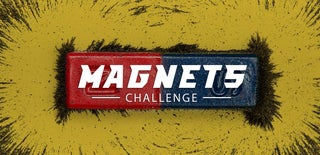Introduction: Magic Floating Paperclip
Here's how to make a magical floating paperclip toy that provides hours, or at least minutes, of entertainment! The trick is to hide a strong magnet inside the base, strong enough to attract a paperclip through a 1/4"-thick layer of plywood.
Supplies
- 1/4" plywood stock (inexpensive BB grade works great)
- one large metal paperclip
- flat floss or string
- one compact neodymium magnet with roughly 15lbs of pull
Step 1: Project Inspiration: Messing Around With Magnets
We were surprised that one of the shop magnets we use for prototypes was strong enough to attract a paperclip through a piece of plywood. After goofing around with some LEGOs, we thought about how we might make a more durable "magic" paperclip trick.
Step 2: Design the Model in CAD
This was a quick weekend project. We experimented with creating a rough Fusion 360 model with a few parameters but without fully constraining each body with complete dimensions.
The part was designed to be laser-cut from plywood, with legs that would also sandwich the layers of the stacked plywood cylindrical "box" holding the high-strength magnet.
One important user-parameter is the plywood thickness. We're using cheap "BB" grade baltic birch plywood from Home Depot, and sheets vary in thickness. You can set these parameters in Fusion 360 in the Solid > Modify > Change Parameters menu.
Given that we wanted the legs to press-fit against the stacked layers of the cylinder, we also experimented with a parameter for the laser kerf, or the thickness of the laser's cut. Keep in mind that the laser actually cuts a v-shaped notch that's wider at the top, rather than a cut with parallel edges.
Fusion build notes:
- When creating stacks of parts, use "Modify > Align" instead of "Modify > Move/Copy". This will move parts together if it becomes necessary to change the plywood thickness.
- Use "Inspect > Section Analysis" to create a section plane
- use "Inspect > Inspect" to measure notch-widths
- use "Inspect > Interference" to make sure parts aren't overlapping
To convert the 3D CAD file into 2D DXF files for laser cutting:
- build the part out of separate bodies
- create a sketch on each plane
- rename the sketch to the name of the part
- right click sketch and "Export as DXF"
- import each DXF into CorelDraw, duplicate as necessary
Attachments
Step 3: Cut the Parts on the Laser
We use CorelDraw to prepare parts for laser-cutting on our Epilog machine. We have saved default values for cutting plywood, and for etching and rastering text and art. In the attached file, we use RGB green for raster, RGB red for etch lines and RGB blue for cut lines--and we have the machine process the layers in that order (raster, etch then cut).
A single copy of the magic paperclip stand took about five minutes to raster, etch and cut on the laser--fast enough that we can bang these out as a demo when we're giving workshop tours. These kinds of souvenirs are a great way to recycle scrap plywood.
Step 4: Assemble and Glue If Necessary
Some notes on assembly:
- Before assembly, we added a tiny scrap of foam inside the magnet void (underneath) to stop the magnet from rattling
- The parts weren't quite press fit, so we used Elmer's wood glue and held the parts in place with a Circumferential rubber band while the glue dried
- We tried both polyester thread, dyneema fishing line and flat floss to hold the paper clip. The floss made the most satisfying "bong" when the paperclip stopped above the magnet.
Notes on magnets:
- the current models uses an odd rectangular SB6C4-OUT magnet from K&J Magnetics. This is 1/4" thick and has an estimated pull of 15.7 lbs. For orders of more than 10 units, the magnet costs $3.03
- consider replacing with a cylindrical D93-N52, 3/16" thick and 9/16" diameter, 14 lbs of pull and a unit cost of $2.04.
- At 3/16", 0.19" or 4.76mm, the D93-N52 should press-fit inside a single layer of plywood and thus eliminate one of the two middle layers of the plywood sandwich.
Step 5: Amaze Your Friends, Teachers
We found these paperclip tricks made excellent year-end thank you gifts for teachers.

Participated in the
Magnets Challenge











